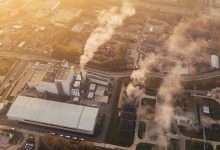In an Australia first, the federal court has handed an Australian company a $500,000 fine for the unlawful importation of a synthetic greenhouse gas with an extreme potential to contribute to global warming, thousands of times worse than carbon dioxide.
The court identified the company as ‘ACN 089 171 415 Pty Ltd’, which ASIC registers show formerly traded under the name ‘Fire Protection Technologies Pty Ltd’, and found it had breached legislation designed to regulate the importation and use of synthetic greenhouse gases and prevent the use of gases that contribute to ozone depletion.
The Ozone Protection and Synthetic Greenhouse Gas Management Act requires companies to obtain licences and quotas to import halocarbon gases, which are often used as refrigerants and fire fighting requirement, but which can be thousands of times worse than carbon dioxide in terms of their contribution to global warming.
In a decision handed down on Tuesday, Federal Court judge Debra Mortimer found that the company had imported 5,000kg of the synthetic greenhouse gas HFC-227ea into Australia from China without proper authorisation.
Declaring that there had been a breach of the licencing rules, the Federal Court affirmed a penalty of $500,000 was to be imposed on the company, as well as being ordered to undertake the destruction of the gas.
The company fined had imported HFC-227ea for use in fire suppression systems, and had sought a licence to import the gas, but the application for the licence had been returned after it had been determined that the company did not have sufficient import quota to bring the gas into Australia.
However, despite not holding the required licence, the company pressed ahead an imported the gas anyway, causing a breach of legislation designed to control the transport and use of ozone depleting materials and gases with enormous potential to contribute to global warming.
The Department of Agriculture, Water and the Environment discovered the company had imported five cylinders, each containing one tonne of the synthetic greenhouse gas, which had been delivered to sites in Victoria and Western Australia. At least two tonnes of the case had been either sold or used by the company for fire suppression systems.
The court accepted that it would likely cost the company around $100,000 to properly dispose of the gas, as well as causing the company to forego sales related to its fire suppression systems that use the gas, and that this had been accounted for as part of the penalties imposed on the company.
HFC-227ea is a controlled substance, and is subject to multiple international treaties, as while the substance is often used as an ozone friendly alternative to other gases used in fire suppression the gas has a powerful contributor to global warming, with a global warming potential that is 3,220 more powerful than carbon dioxide.
In submissions made on behalf of the federal minister for the environment, the court was told that the amount of gas imported was the equivalent of around 16,100 tonnes of carbon dioxide emissions, and that this was a significant contribution to Australia’s overall emissions footprint, and therefore justified the fine imposed.
“In Australia, a typical passenger vehicle emits about 2.438 tonnes of CO2 in an average year. Accordingly, 16,100 tonne CO2 equivalence is equivalent to the annual emissions from 6,600 passenger vehicles, or the driving population of a medium-sized town,” council acting for the federal environment minister told the court.
“The average Australian household generates over 7 tonnes CO2 equivalent annually. Accordingly, 16,100 tonne CO2 equivalence is approximately equivalent to the annual impact of an additional 2,300 households.”
However, the court did downplay the wide-scale significance of the importation of the synthetic greenhouse gas, particularly when compared to other sources of emissions.
“The joint submissions also contend that any harm caused by contraventions of the scheme will be “suffered incrementally by the entire population of the Earth, including its flora and fauna”.
“That may be an overly dramatic description of the nature of the harm caused, or likely to be caused, by this particular contravention – especially if the Court were to take judicial notice of the continuing range of carbon emitting activities presently occurring in Australia,” the judgement says.”
HFC-227ea ranks as the fifth most potent of the 18 varieties of hydrofluorocarbon (HFC) gases regulated under the Ozone protection act.










